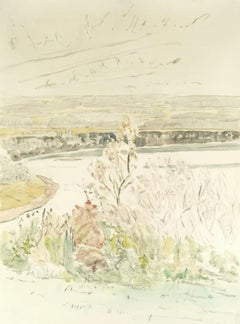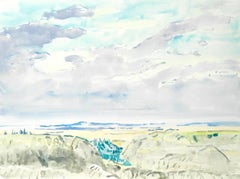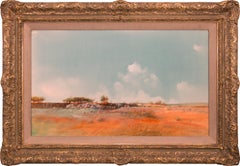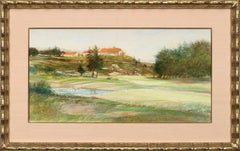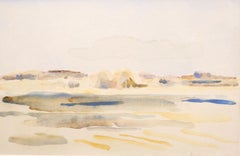Dorothy Knowles Landscape Paintings
to
2
Overall Width
to
Overall Height
to
2
2
1
1
1
1
1
1
1
1
2
2
2
669
600
314
229
Artist: Dorothy Knowles
View of a cove
By Dorothy Knowles
Located in Westmount, QC
Dorothy Knowles, Canadian, b. 1927
Watercolour, 1982
30 x 22 1/2 in
76.2 x 56.2cm
signed and dated ‘D.Knowles.82.’ (lower right)
PROVENANCE
Property from the Collection of Theo Waddington, London, UK
framed
Dorothy Knowles Biography
(1927 - 2023) RCA
Dorothy Elsie Knowles was born on April 7, 1927 in Unity, Saskatchewan. She grew up on a farm overlooking a Prairie valley and initially had no plans to become a painter, studying biology at the University of Saskatchewan in Saskatoon between 1944 and 1948. At the time of her graduation, a friend persuaded her to enroll in a six-week summer course given by the University of Saskatchewan at Emma Lake. The course was led by Reta Cowley from Saskatoon and James Frederick Finley from the Ontario College of Art and under their guidance young Dorothy found a proclivity for art. Upon her return to Saskatoon she continued to study painting under Eli Bornstein...
Category
1980s Dorothy Knowles Landscape Paintings
Materials
Watercolor
View of the sea
By Dorothy Knowles
Located in Westmount, QC
Dorothy Knowles, Canadian, b. 1927
Watercolour, 1982
22 1/2 x 30 in
signed lower right
PROVENANCE
Property from the Collection of Theo Waddington, London, UK
framed
Dorothy Knowles Biography
(1927 - 2023) RCA
Dorothy Elsie Knowles was born on April 7, 1927 in Unity, Saskatchewan. She grew up on a farm overlooking a Prairie valley and initially had no plans to become a painter, studying biology at the University of Saskatchewan in Saskatoon between 1944 and 1948. At the time of her graduation, a friend persuaded her to enroll in a six-week summer course given by the University of Saskatchewan at Emma Lake. The course was led by Reta Cowley from Saskatoon and James Frederick Finley from the Ontario College of Art and under their guidance young Dorothy found a proclivity for art. Upon her return to Saskatoon she continued to study painting under Eli Bornstein...
Category
1980s Dorothy Knowles Landscape Paintings
Materials
Watercolor
Related Items
"Flat Lands" Original Landscape Mixed Media on Paper by Tom Perkinson, Framed
By Tom Perkinson
Located in Encino, CA
"Flat Lands" is an original mixed media on paper by Tom Perkinson. His use of saturated violets, vivid yellows, and resplendent oranges pushes color to almost-otherworldly realms. Th...
Category
1970s Realist Dorothy Knowles Landscape Paintings
Materials
Pastel, Ink, Mixed Media, Watercolor, Color Pencil
$5,500
H 26.625 in W 38.375 in D 2.5 in
"1940 - Number Nine" Original Mixed Media on Board by Tom Perkinson, Framed
By Tom Perkinson
Located in Encino, CA
"1940 - Number Nine" is an original mixed media on board by Tom Perkinson. His use of saturated violets, vivid yellows, and resplendent oranges pushes colo...
Category
1980s Realist Dorothy Knowles Landscape Paintings
Materials
Pastel, Ink, Mixed Media, Watercolor, Color Pencil
$3,500
H 20.5 in W 32.5 in D 1.125 in
"Reflections in the Pond" Large Mixed Media on Board by Tom Perkinson, Framed
By Tom Perkinson
Located in Encino, CA
"Reflections in the Pond" is an original mixed media on board by Tom Perkinson. His use of saturated violets, vivid yellows, and resplendent oranges pushes color to almost-otherworld...
Category
1970s Realist Dorothy Knowles Landscape Paintings
Materials
Ink, Color Pencil, Watercolor, Mixed Media, Pastel
$6,500
H 31.875 in W 43.5 in D 2.875 in
"Plains Indian Camp" Lrg Original Mixed Media on Paper by Tom Perkinson, Framed
By Tom Perkinson
Located in Encino, CA
"Plains Indian Camp" is an original mixed media on paper by Tom Perkinson. His use of saturated violets, vivid yellows, and resplendent oranges pushes colo...
Category
1980s Realist Dorothy Knowles Landscape Paintings
Materials
Pastel, Ink, Mixed Media, Watercolor, Color Pencil
$8,000
H 32.625 in W 43.125 in D 1 in
"Spring Sassafras" Original Mixed Media on Board by Tom Perkinson, Framed
By Tom Perkinson
Located in Encino, CA
"Spring Sassafras" is an original mixed media on board by Tom Perkinson. His use of saturated violets, vivid yellows, and resplendent oranges pushes color to almost-otherworldly real...
Category
1970s Realist Dorothy Knowles Landscape Paintings
Materials
Pastel, Ink, Mixed Media, Watercolor, Color Pencil
$5,500
H 26.875 in W 36.875 in D 2.875 in
"Collecting Cattails" Original Mixed Media on Board by Tom Perkinson, Framed
By Tom Perkinson
Located in Encino, CA
"Collecting Cattails" is an original mixed media on board by Tom Perkinson. His use of saturated violets, vivid yellows, and resplendent oranges pushes color to almost-otherworldly r...
Category
1970s Realist Dorothy Knowles Landscape Paintings
Materials
Pastel, Ink, Mixed Media, Watercolor, Color Pencil
$3,000
H 23.75 in W 27.75 in D 2 in
View of the surroundings of Saint-Cloud from Meudon near Paris in France
Located in BELEYMAS, FR
Antoine-Ignace MELLING
(1763 Karlsruhe - 1831 Paris)
View of the surroundings of Saint-Cloud from the terrace of Bellevue in Meudon
Watercolor and gouache
H. 62.5 cm; W. 93.5 cm
Sign...
Category
1810s French School Dorothy Knowles Landscape Paintings
Materials
Paper, Watercolor
$54,188
H 24.61 in Dm 36.82 in
'Towards Le Scathe Cove'. Contemporary Landscape, Rural, Sea, Ocean, Beach Blue
By Sophia Milligan
Located in Penzance, GB
'Towards Le Scathe Cove'. Contemporary mixed media landscape painting, Cornwall
Original Artwork, Unframed
_________________
January morning, heavy swell and a strong southwester, rain imminent, sheltering beneath lichen furred granite outcrops.
A plein air painting from the series 'Holan ha Dor' (Meaning 'Salt and Earth in Cornish). West Cornwall is a harshly beautiful peninsula, jutting out into the wild tireless ocean, shaped and moulded by powerful salt laden Atlantic winds, and criss-crossed by ancient, tangled hedgerows. Drawn to the immediacy of moments, underpinned by enduring narratives, Sophia's fluid expressive paintings explores the flux and balance in the nature of all things: The freedom of the air and solidity of the soil; Of anchored stone and rhythmic water; Of human narratives written in the wild landscapes; In the sensual interplay of light and shadow. They capture an essence of the equilibrium between wild raw energy and serene stillness; chaos and harmony; and the enduring and the effervescent.
Mixed media on watercolour paper
Signed and inscribed
Unframed
23 x 30cm / 9 x 12 inches
__________________________
About The Artist
Sophia Milligan is a contemporary multidisciplinary artist, exploring discourses on permanence & evanescence; the eternal, cyclical absolutes of birth & death; motherhood & childhood; and ancient immutable connections. With resonating ripples of intuition and instinct Sophia illuminates the presence of the ordinary, creating moments of sublime present.
'Born among the wild cliffs and tempestuous seas of west Cornwall, I grew with the intimate details in the twisting lanes and the intense changing light throughout the turbulent seasons. I formed a primordial connection with a deep instinctual sense of being part of the natural narrative, and wherever in the world I may be, this connectivity underpins my practice. Like the wind sculpted hawthorns and sensual coves of weather worn granite, I have been shaped by the powerful energy entwined in this ancient raw environment.’
‘We are the stories of the journeys that came before. I weave into my work the tales of transitory circumstance; of struggle and survival; of forms and textures holding records of evolutionary millennia. I paint, I draw: with marks, mixtures, photography, words; the raw earth; the restless oceans; the whispered breeze. I work with time, and the immeasurable spaces of experience within, giving subtleties of existence a pause for contemplation. There is beauty in such poignant breaths. All moments are significant, every pebble of now forms the vast mountain of yesterday, and the great realm of tomorrow's possibilities'.
Sophia has a 1st class honours Bachelor of Arts Degree in Visual Arts and World History, and a Masters Degree in Contemporary Visual Arts. Her work is held in prestigious international private collections, and exhibitions of her interactive, immersive installation, photography and mixed media works include 'Tabula Rasa', London; 'Superlative', Plymouth; 'Transition', Newlyn; The Eden Project, Cornwall; The European Parliament, Brussels; Kew Gardens, London; and 'The Cameraless Film Festival', Chicago...
Category
2010s Contemporary Dorothy Knowles Landscape Paintings
Materials
Ink, Watercolor, Archival Paper, Crayon, Wax, Acrylic, Color Pencil
Sophia Milligan'Towards Le Scathe Cove'. Contemporary Landscape, Rural, Sea, Ocean, Beach Blue, 2022
$344 Sale Price
50% Off
H 9 in W 12 in
Untitled: Abstract Figure and Leaves
By Gio Colucci
Located in Berlin, MD
Gio Colucci (Italian 1892-1974) Untitled: Abstract Figure and Leaves. Gouache on paper laid down on matt board. Archival framing under glass. Originally from the Con-Agra Corporat...
Category
Early 20th Century Abstract Dorothy Knowles Landscape Paintings
Materials
Gouache, Laid Paper
Zamość - XXI century, Gouache on cardboard, Figurative, Landscape
By Magdalena Spasowicz
Located in Warsaw, PL
MAGDALENA SPASOWICZ Studied painting under prof. Jan Cybis and graphic arts with prof. Tadeusz Kulisiewicz at the Academy of Fine Arts in Warsaw. She received her diploma in 1953. He...
Category
21st Century and Contemporary Other Art Style Dorothy Knowles Landscape Paintings
Materials
Gouache, Cardboard
$1,023
H 15.75 in W 19.69 in
Wash Day, Coastal Stream
By Jules Noel
Located in Greenville, DE
Signed lower right dated 1875.
Category
1870s Realist Dorothy Knowles Landscape Paintings
Materials
Watercolor, Gouache
Tenement house - XXI Century, Gouache on paper, Architecture, Landscape
By Piotr Fąfrowicz
Located in Warsaw, PL
PIOTR FĄFROWICZ (born in 1958). He studied art history at the Catholic University of Lublin. He deals with painting and graphic design. Winner of numer...
Category
21st Century and Contemporary Other Art Style Dorothy Knowles Landscape Paintings
Materials
Paper, Tempera, Gouache
$782
H 11.42 in W 8.27 in
Previously Available Items
untitled
By Dorothy Knowles
Located in Westmount, QC
Dorothy Knowles, Canadian, b. 1927
Untitled, 1980
w/c on paper
7 x 10 in
signed lower right
framed
Dorothy Knowles Biography
(1927 - 2023) RCA
Dorothy Elsie Knowles was born on April 7, 1927 in Unity, Saskatchewan. She grew up on a farm overlooking a Prairie valley and initially had no plans to become a painter, studying biology at the University of Saskatchewan in Saskatoon between 1944 and 1948. At the time of her graduation, a friend persuaded her to enroll in a six-week summer course given by the University of Saskatchewan at Emma Lake. The course was led by Reta Cowley from Saskatoon and James Frederick Finley from the Ontario College of Art and under their guidance young Dorothy found a proclivity for art. Upon her return to Saskatoon she continued to study painting under Eli Bornstein...
Category
1980s Dorothy Knowles Landscape Paintings
Materials
Watercolor
Dorothy Knowles landscape paintings for sale on 1stDibs.
Find a wide variety of authentic Dorothy Knowles landscape paintings available for sale on 1stDibs. You can also browse by medium to find art by Dorothy Knowles in paint, watercolor and more. Not every interior allows for large Dorothy Knowles landscape paintings, so small editions measuring 22 inches across are available. Customers who are interested in this artist might also find the work of Andrea Stajan-Ferkul, Bruno Côté, and Robert Lemay. Dorothy Knowles landscape paintings prices can differ depending upon medium, time period and other attributes. On 1stDibs, the price for these items starts at $1,750 and tops out at $1,750, while the average work can sell for $1,750.
